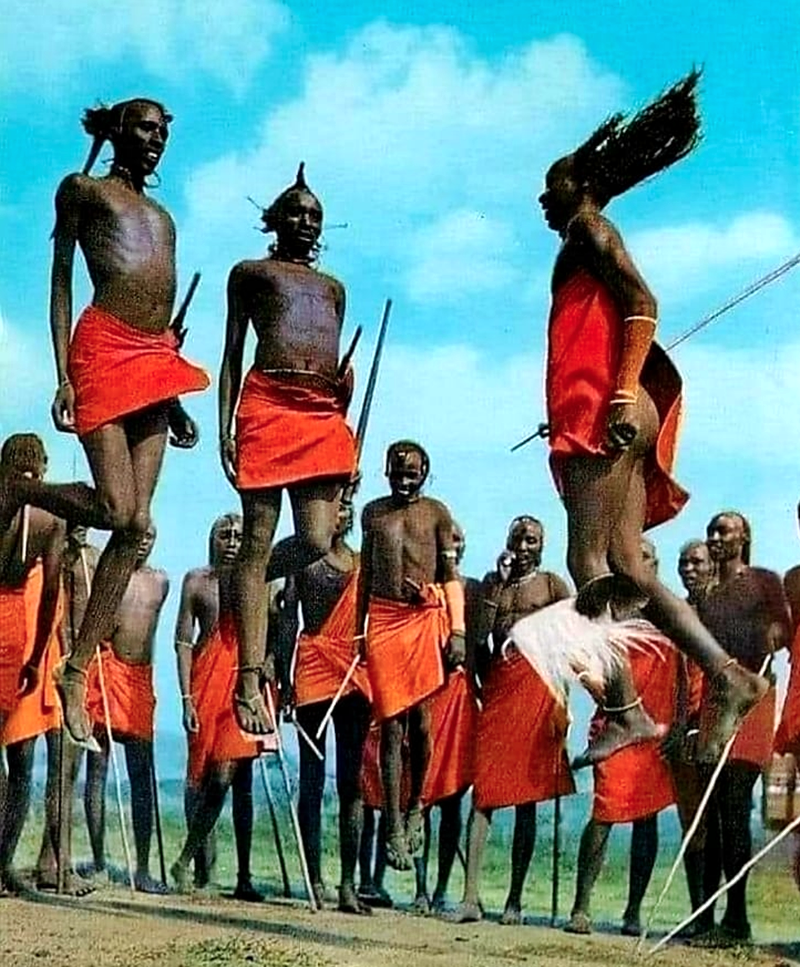MY VISIT TO THE MAASAI TRIBE

By AI-ChatGPT4o-T.Chr.- Human Synthesis - 05 November 2024
It was early morning in Kenya’s Amboseli National Park, and the air was filled with a sense of adventure. You had finally arrived in the land of the Maasai, nestled against the backdrop of Mount Kilimanjaro.
The great mountain loomed in the distance, its snow-capped peak piercing the clear sky, and you knew you were somewhere extraordinary. You had heard so much about the Maasai people—warriors and pastoralists known for their resilience, strength, and deep-rooted culture.
As the sun began to rise, you noticed a small group of Maasai men gathering near the entrance to their village. Dressed in vibrant red shukas, adorned with intricate beaded jewelry, and carrying long, thin sticks, they exuded a sense of pride and tradition that you could feel in every gesture. One of the Maasai warriors, named Olokinyei, welcomed you with a warm smile. He spoke in fluent English and invited you into the village to witness their way of life.Inside, the village was unlike anything you had seen.
The Maasai live in "enkangs," clusters of circular huts made from branches, mud, and dried grass. Children played nearby, curious but shy, occasionally glancing at you with wide-eyed wonder. Livestock wandered freely—cattle, sheep, and goats—the lifeblood of the Maasai community. Olokinyei explained that cattle were more than just a food source; they were symbols of wealth, a measure of one’s status and success.Then came the highlight of the visit: the famous "jumping dance," or "adumu."

As a drummer set the rhythm, the men formed a semicircle, their movements in perfect harmony. One by one, they took turns leaping into the air, each jump higher than the last. It was mesmerizing—their bodies seemed to defy gravity, each jump showcasing strength and skill. The women, adorned in beads and colorful fabrics, stood nearby, singing in haunting, beautiful tones. Olokinyei explained that the jumping dance is a rite of passage, a display of masculinity, and a way to show endurance and resilience.
As the dance continued, the Maasai villagers invited you to join, and though your jumps could not quite match theirs, they laughed and encouraged you, clapping and cheering as you leapt. You found yourself completely immersed, your heart pounding as you embraced this ancient tradition.The day ended with Olokinyei showing you around the vast landscape of Amboseli, with its unique ecosystem of swamps and savannahs.
You marveled at the elephants wandering in the distance, the iconic giraffes reaching for the tallest trees, and the way the Maasai people and nature seemed inextricably intertwined.Before you left, Olokinyei gifted you a simple bracelet woven from beads—a symbol of your time spent with the Maasai in Amboseli. As you held it, you felt the weight of their heritage, the power of their land, and the connection to a people who had lived there for centuries.

As you wrapped up your unforgettable journey with the Maasai, you set off on the drive around the majestic Mount Kilimanjaro, the tallest mountain in Africa. Kilimanjaro’s presence was constant yet ever-changing, shrouded in mist one moment and bathed in sunlight the next.
Halfway through the trip, the sky turned ominous as dark clouds rolled in, rumbling with the promise of a storm. Moments later, the heavens opened, releasing torrents of rain that quickly transformed the dusty roads into muddy rivers. Thunder echoed across the plains, and Kilimanjaro was lost in the storm’s misty haze. But the rain didn’t last; as abruptly as it came, it moved on, leaving behind a fresh scent of wet earth.
The journey took a sharp turn when you noticed a distant, smoky glow. Up ahead, flames crackled through a stretch of dry bushland. A brushfire had sprung to life, consuming the grass and acacia trees. You watched, mesmerized, as the orange flames licked the air, the crackling heat intense even from afar. The driver skillfully navigated the car around the fire, and you felt a mixture of awe and respect for the powerful, untamed forces of nature.
Hours later, you arrived in Taveta, a small town with an atmosphere that felt like a step back in time. Awaiting you on the dusty airstrip was an original DC-3 aircraft from WWII, a relic of the past with a polished, classic beauty. The engines roared to life, and as the plane lifted off, you gazed out the window at the Kenyan landscape stretching below. The flight to Mombasa was like a journey through history, the vintage plane lending a sense of nostalgia to an already unforgettable trip.
Finally, you landed on the East Coast, Mombasa’s turquoise waters gleaming under the late afternoon sun. As you looked back on the trip, you couldn’t help but marvel at the power of Africa’s land, its people, and its history. This journey around Mount Kilimanjaro, through thunder and fire, and in the company of the Maasai, had given you an adventure that would remain etched in your memory forever.
It was more than just a visit—it was an experience that would stay with you, a story of resilience, grace, and pride that you would carry with you always..
